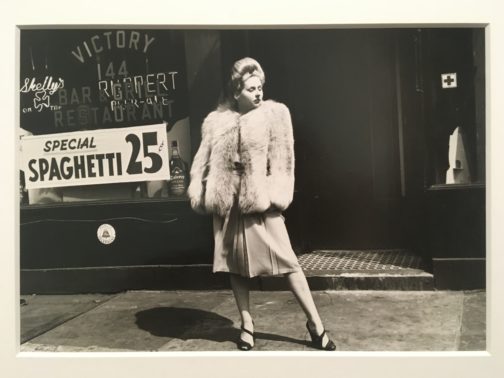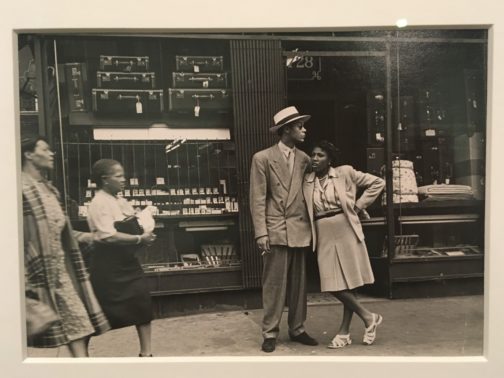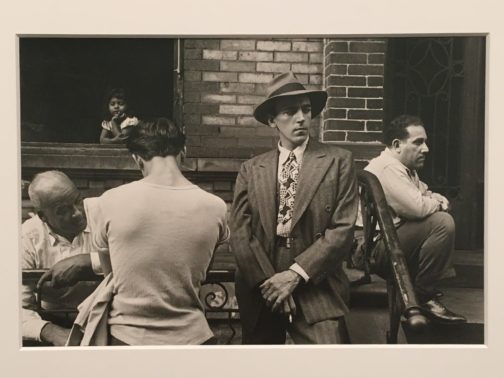Helen Levitt’s (1913-2009) photography presents life on the streets of her native New York from the 1930s to 1990s. The current exhibition of her work at The Photographers’ Gallery in London gives insight on a world of charm and character often overlooked in a time and place associated with hardship.
What struck me about many of the photographs in the exhibition was the street style they showed, particularly of 1940s New York, and how this style seemed to embody the ease and coolness of residents whilst also creating a protective armour that shielded them from potential harm.

The first image I have featured exudes glamour (Fig. 1). The woman stands powerfully in the centre of the frame, her large hairdo and statement fur coat making her appear more a fashion model than everyday resident. She turns her head away from the camera, nonchalant despite her bold presence. The photograph might be a snapshot, but something in the woman’s pose implies a knowledge that she is being photographed. She wants to appear powerfully glamourous. Behind her, in a storefront window, is a sign for spaghetti being sold for 25 cents. The spaghetti sign grounds the image. The woman is in her local area, and Levitt chooses to show us those surroundings rather than strategically shooting a more glamourous background to suit the look of the woman.
In this image I see optimism for the beginning of a new decade that this woman seems determined to succeed in. However, the fur coat with its strong shoulder pads also suggests protection, as if the woman is cocooning herself in a thick wall of fur to defend herself from the harsh realities of the world she faces. We lose all sense of the woman’s proportions beneath the heavy coat. She is emboldened by the layers of clothing she has ensconced herself in.

The second photograph is as glamourous as the first (Fig. 2). A couple stand together, woman leaning on man, both impeccably dressed. Levitt has captured the woman mid-speech, and two more women are walking across the scene from the left-hand side. This all comes together to present a far more snapshot-like image than the first.
The man’s oversized zoot suit, paired with hat, sunglasses, and loosely held cigarette, all contribute to create an image of effortlessness but also serve as a kind of armour, similar to the fur coat of the woman in the first image. The shoulder pads and loose suit trousers conceal the shape of his body, and the sunglasses restrict the expression that can be gleaned from his facial features.
The woman’s casual pose leaning against the man at first suggests ease and comfort. However, a layer of defence can also be seen in the sharp angle of her elbow, pointed out towards the street on her exposed side.

The final image I would like to discuss perhaps best highlights the way fashion served as protective armour in 1940s New York (Fig. 3). The man facing the camera stands in a striped suit, hands clasped in front of him, fedora casting a shadow across his forehead. What is most notable about the man’s outfit is its bold use of pattern. A striped suit is paired with a checked shirt and graphic tie. The clash of patterns reveals the man’s confidence styling himself, and his confidence asserting his place with striking visual presence.
Beside the man stands a far less extravagantly dressed individual. We only see his back, but can see he has removed his jacket and stands in a t-shirt, the shape of his shoulder blades showing through the fabric. This figure, next to the powerful stance of the suited man, becomes a figure of vulnerability. The composition almost gives the impression we are seeing two sides of the same man; the confident figure who faces the world, and the softer side of himself that cannot be fully revealed to the camera. A child in the window of the building looks down on the man who faces away from us, adding to the sense that this lack of layers of clothing is a childlike kind of vulnerability.
‘Helen Levitt: In The Street’ is on show at The Photographers’ Gallery until 13th Feb 2022.
By Megan Stevenson

